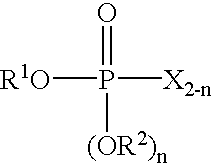Process for producing phosphorohalidate
a technology of phosphorohalidate and halidate, which is applied in the direction of organic chemistry, group 5/15 element organic compounds, physical/chemical process catalysts, etc., can solve the problems of disproportionation reaction during distillation process, purity and yield of desired phosphorohalidate cannot be substantially increased, etc., to achieve high purity, high yield, and suppress disproportionation reaction
- Summary
- Abstract
- Description
- Claims
- Application Information
AI Technical Summary
Benefits of technology
Problems solved by technology
Method used
Image
Examples
example 2
Distillation was carried out under reduced pressure (31 mmHg) in the same manner as in Example 1 except that 0.55 g (half the amount used in Example 1) of sodium carbonate was used with 861 g of crude product (1) obtained in the same manner as in Example 1. The initial fraction was collected at a distillation temperature from 120.degree. C. to 1410C. The main fraction was collected at a distillation temperature from 141.degree. C. to 158.degree. C. over a period of 10 hours. The remainder was the residual fraction. Table 1 presented below shows the weights and compositions of the initial fraction, main fraction and residual fraction. The purity of the phenylphosphorodichloridate in the main fraction obtained by distillation was 100%.
example 3
A 1-liter four-necked flask equipped with a stirrer, a thermometer and a condenser was charged with 376 g of phenol, 921 g of phosphorus oxychloride and 1 g of magnesium chloride (a catalyst). The mixture was stirred while it was heated and the reaction temperature was gradually raised to 90.degree. C. over a period of 6.5 hours. confirming that unreacted phenol was not left, the reaction was stopped. The hydrogen chloride gas produced during the reaction was introduced into a water scrubber. Then, the pressure was gradually reduced to 100 mmHg and the temperature was raised to 120.degree. C. to collect the excess phosphorus oxychloride. The crude product obtained from the reaction (hereinafter referred to as "crude product (2)") weighed 856.7 g. Table 1 presented below shows the composition of crude product (2).
Subsequently, distillation was carried out under reduced pressure (30 mmHg) in the same manner as in Example 1, except that 0.9 g of sodium chloride was used with 630.1 g of...
example 4
A 1-liter four-necked flask equipped with a stirrer, a thermometer and a condenser was charged with 376 g of phenol, 921 g of phosphorus oxychloride and 1 g of magnesium chloride (a catalyst). The mixture was stirred while it was heated and the reaction temperature was gradually raised to 95.degree. C. over a period of 6.5 hours. Confirming that unreacted phenol was not left, the reaction was stopped. The hydrogen chloride gas produced during the reaction was introduced into a water scrubber. Then, the pressure was gradually reduced to 100 mmHg and the temperature was raised to 120.degree. C. to collect the excess phosphorus oxychloride. The crude product obtained from the reaction (hereinafter referred to as "crude product (3)") weighed 850.3 g. Table 1 presented below shows the composition of crude product (3).
Subsequently, distillation was carried out under reduced pressure (30 mmHg) in the same manner as in Example 1, except that 1.1 g of sodium chloride was used with 631.2 g of...
PUM
| Property | Measurement | Unit |
|---|---|---|
| temperature | aaaaa | aaaaa |
| temperature | aaaaa | aaaaa |
| temperature | aaaaa | aaaaa |
Abstract
Description
Claims
Application Information
 Login to View More
Login to View More - R&D
- Intellectual Property
- Life Sciences
- Materials
- Tech Scout
- Unparalleled Data Quality
- Higher Quality Content
- 60% Fewer Hallucinations
Browse by: Latest US Patents, China's latest patents, Technical Efficacy Thesaurus, Application Domain, Technology Topic, Popular Technical Reports.
© 2025 PatSnap. All rights reserved.Legal|Privacy policy|Modern Slavery Act Transparency Statement|Sitemap|About US| Contact US: help@patsnap.com

